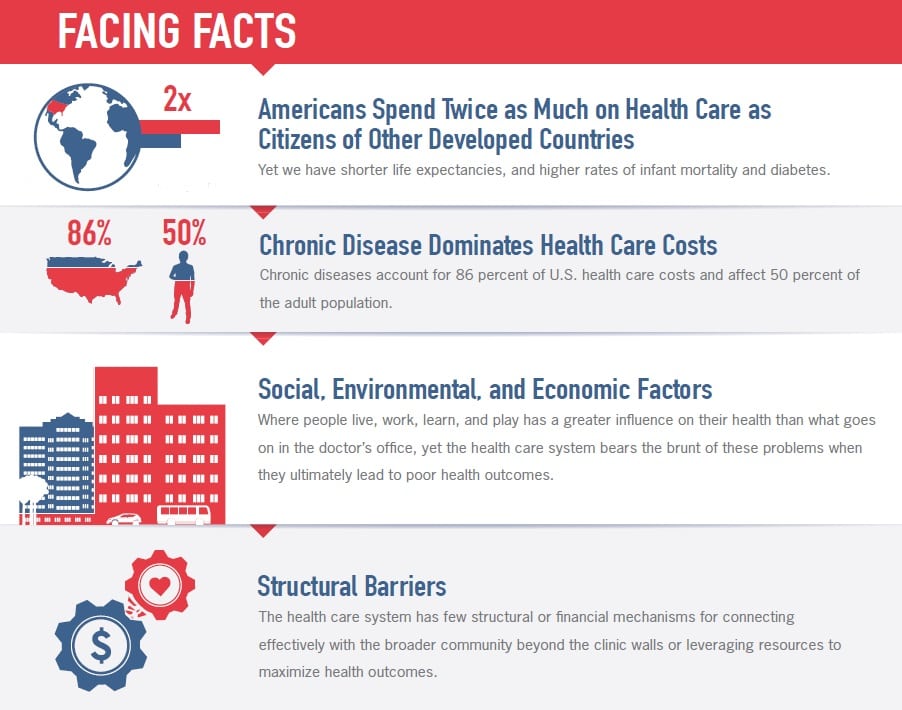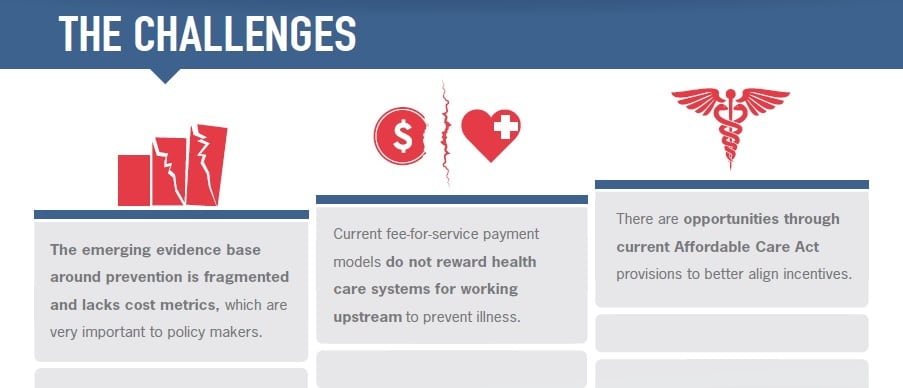A Prevention Prescription for Improving Health and Health Care in America
In 2014, the Bipartisan Policy Center (BPC) convened a Prevention Task Force to focus on opportunities for investing in prevention as a way to improve health outcomes and reduce health care costs. The task force included a diverse group of experts to review the evidence on prevention and to frame a strategy for better integrating prevention in the nation’s approach to health and health care.
Fundamentally, there is growing recognition that prevention?delivered correctly?holds vast potential to improve health at the individual and population level, while also reducing national spending on health care. Better health is an important goal in and of itself, with benefits?in productivity, longevity, wellbeing, and quality of life?that extend to all levels of society, from individuals and families to communities, businesses, and government. Of course, not all prevention strategies will be effective, and not all health improvements will result in cost savings. But prevention clearly has a role to play in advancing several widely shared objectives of current health care reform efforts.
Interest in tapping that potential has gained momentum recently, spurred by major policy developments, such as the passage of the Affordable Care Act, and by growing awareness of the linkages that exist among high rates of obesity and chronic disease, rising health care costs, and poor health outcomes for many Americans.
The critical questions now center on how to pursue greater integration and overcome complex challenges?such as realigning incentives within the health care system to improving coordination, bridging the gap between clinic and community, and finding ways to evaluate interventions and measure impacts that are inherently complex and long-term.
A Two-Part Framework for Progress on Prevention
The task force proposes a two-part framework to address these challenges and to begin accelerating investment in prevention-oriented strategies. This framework recognizes that preventable chronic conditions are widespread and costly, that much of the work of effective prevention strategies must occur outside the doctor’s office, that the current understanding of what approaches are effective in non-clinical settings is limited, that problems as complex as obesity and chronic disease will require multiple interventions to show impact, that accomplishing a shift toward disease prevention and wellness will require new kinds of integrated entities and financing mechanisms, and that it will be important to test the effectiveness of these new strategies and entities.
Recommendations
The task force’s first set of recommendations focus on building the evidence base for prevention. To capture and translate the best available information on effective interventions and to develop appropriate metrics for evaluating progress, we recommend:
The Centers for Disease Control and Prevention (CDC) and the National Institutes of Health should include a requirement for economic analysis (or cost-effectiveness analysis) in clinical and public health funding opportunity announcements (FOAs) to help build cost-related evidence from public health interventions. The same requirements should be applied to clinical interventions as well.
The Centers for Medicare and Medicaid Services (CMS) should include a requirement for economic analyses (or cost-effectiveness analysis) in FOAs to help build cost-related evidence from public health interventions.
Public health journals should give priority to, and thereby encourage, economic analysis in studies of prevention strategies.
Public and private funders should encourage and fund studies of the health and economic effects of proven and emerging population-level interventions and prevention strategies. In particular, funders should take advantage of “real world” natural experiments (affecting 10,000+ individuals) to investigate the population-level health and fiscal effects of integrated community prevention and clinical care interventions.
Congress should assure adequate funding for the CDC Community Preventive Services Task Force with the aim of expanding the number of community-level public health interventions that can be reviewed for inclusion in, and wide dissemination through, the CDC’s Guide to Community Preventive Services and other evidence-based sources. These reviews identify interventions that are and are not ready for wide implementation, as well as the research needed to address key evidence gaps.
Congressional budget committees should direct the Congressional Budget Office (CBO) to use “present discount accounting” to bring long-term savings from prevention “up” in time and to align better with CBO’s current 10-year scoring window; these changes will help ensure that CBO is accounting for benefits that might be seen 20?25 years out.
The second part of the task force’s framework focuses on near-term opportunities to embed prevention in broader health care delivery system reforms. We recommend:
CMS should integrate at least two (and preferably more) population health care quality measures into the next iteration of accountable care organization to drive system change that supports health by reducing the prevalence of risk factors and the incidence of disease.
CMS, through its Center for Medicare and Medicaid Innovation (CMMI) should invest in a robust demonstration of an accountable health community (AHC) model, which could establish a concrete framework for improving population health while leveraging the existing delivery-system infrastructure.
CMS should invest in evaluating AHC models that focus on establishing funding mechanisms that can be both scaled and sustained over time. Investments in AHCs should include specific provisions (and funding) for (a) identifying the full suite of relevant stakeholders (including stakeholders whose downstream budgets might benefit from effective upstream prevention), (b) identifying shared outcomes as a basis for pooling financial resources, (c) providing an integrator, (d) using innovative mechanisms to address the “wrong pocket” problem, (i.e., where investments and savings may be made by/accrue to different entities, and (e) using technology to share data and support communication.
CMS should support efforts to synthesize and translate lessons learned from CMMI and other programs, including investing in infrastructure to help spread and scale what works and sponsoring analyses to predict likely health and economic impacts in defined populations and jurisdictions. In addition, CMS should consider including requirements for translating and disseminating findings and results in the RFP process.
Communities, public health officials, and hospitals should collectively explore ways to improve Community Health Needs Assessments and better use these assessments as a tool for aligning goals and implementation plans. At the same time, communities, public health officials, and hospitals should engage with other stakeholders to identify existing organizations at the state, regional, or local level that could function as integrators, potentially with additional support from national-level organizations (e.g., the National Association of Counties, the National Association of County and City Health Officials, the Centers for Disease Control and Prevention, and the American Heart Association).
Conclusion
The work of the Prevention Task Force is motivated by a core premise: that engaging a broader array of community-level drivers and resources for disease prevention and health promotion can help more Americans enjoy longer, healthier, and more productive lives while also reducing overall health care spending. Recognizing that the U.S. health care system is still in the early phases of a transformational shift, our goal has been to identify challenges, highlight near-term opportunities for progress, and begin bringing together the diverse organizations and institutions?both within and outside the traditional health care sector?whose resources, expertise, and commitment are needed to deliver on the promise of achieving better health, better health care, and lower health costs through prevention.
Share
Read Next
Downloads and Resources
Support Research Like This
With your support, BPC can continue to fund important research like this by combining the best ideas from both parties to promote health, security, and opportunity for all Americans.
Give NowRelated Articles
Join Our Mailing List
BPC drives principled and politically viable policy solutions through the power of rigorous analysis, painstaking negotiation, and aggressive advocacy.
.png)

